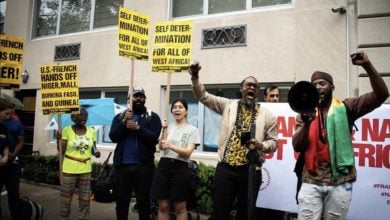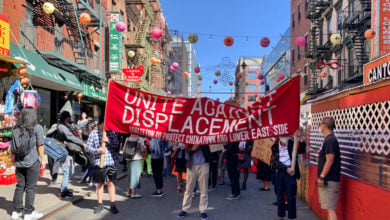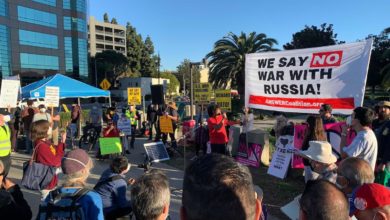 1,700 U.S. soldiers and well over 100,000 of Iraqis have died in the Iraq war so far. Photo: Reuters/Ali Jasim |
At the beginning of the occupation, the U.S. government claimed Iraq would be stabilized rapidly, promising that “Baathist remnants” would be apprehended. This didn’t happen. A strong movement of resistance formed to oppose the occupation.
Then, the United States declared a “turning point” with the phony “handover” of power from the colonial Coalition Provisional Authority, headed by L. Paul Bremer, to the puppet government of Iyad Allawi in late June 2004. But resistance continued.
The U.S. government next put its hopes in the occupation-managed elections. Since then, the resistance has intensified. On April 28, 2005, when the new prime minister, Ibrahim al-Jaafari, formed his cabinet, it was announced that “democracy” had broken the back of resistance. This was hailed as a historic “turning point.” But this proclamation has proved just as hollow as the ones before. The Iraqi resistance has increased its coordination and attacks on the occupation forces and their puppets.
Bourgeois analysts who jump to express “cautious optimism” when there is a slight drop in the number of resistance operations have been forced to express dismay at the continuing resilience of Iraqi resistance. “Those who believed that the elections would be a decisive turning point undermining the insurgency are disappointed yet again,” said Ted Carpenter, a defense analyst at the conservative Cato Institute. “The insurgency seems as capable as ever.”
The U.S. military admits that at least 77 U.S. troops were killed in May 2005, the highest toll since January and the second straight monthly increase in U.S. casualties. According to Lt. Col. Steve Boylan, a U.S. military spokesman in Baghdad, “insurgents are staging about 70 attacks nationwide per day.”
This staggering number of daily operations provides further evidence that resistance to the occupation is the reflection of the will of the Iraqi people. Without widespread popular support, it would be impossible for resistance forces to fight against the U.S. military’s overwhelming firepower.
U.S. lies: ‘Foreign states are behind the insurgency’
U.S. authorities blame foreign “terrorists” and the support of neighboring states for the strength of the Iraqi resistance. During her recent visit to Iraq, Secretary of State Condoleezza Rice said, “We’re going to go back and look again at what the neighbors can do—particularly the Syrians—to stop support for these foreign terrorists who we believe are gathering on Syrian soil and coming across.”
The U.S. authorities are desperate to depict the resistance as anything but the genuine struggle of the Iraqi people against occupation. However, data released by the occupation forces state that less than five percent of those arrested as suspected resistance fighters come from countries other than Iraq.
Regardless, the U.S. continues to use the Iraq war to intensify its threats towards the region. Following a May 28 British Sunday Times report that an injured Abu Musab Al Zarqawi—the purported Al-Qaeda leader in Iraq—had been moved to Iran, Secretary of State Donald Rumsfeld declared, “Any country that decides it wants to provide medical assistance or haven to a leading terrorist, Al-Qaeda terrorist, is obviously associating themselves with Al-Qaeda.”
Such accusations serve a dual purpose. They try to obfuscate the reality that the Iraqi people are overwhelmingly opposed to the occupation. They also set the stage for hostile action against other targets, like Syria and Iran.
Resistance holds up U.S. imperialism
The Iraqi resistance has provided a major challenge to the Bush team’s plans of re-colonizing the Middle East. There are currently 139,000 U.S. troops in Iraq, along with 23,000 British and other foreign soldiers. These troops are tied up fighting against a powerful and increasingly sophisticated resistance. Another 20,000 U.S. troops are occupying Afghanistan.
Because of the success of the resistance, U.S. military recruiters have fallen far short of meeting their recruitment quotas over the past several months. In the words of retired Army Lt. Col. Charles Krohn, “Army recruiting is in a death spiral.” Recognizing the unfeasibility of its May recruitment goal of 8,050, the Army lowered the goal to 6,700 recruits—and still missed the new figure by a full 25 percent.
Resistance operations also have made Iraq an unsuitable market for large-scale capital investment. Capital needs security, which is something that Iraq does not offer at this time.
The plunder of Iraq’s resources has proved challenging as well. By blowing up oil pipelines and sabotaging oil industry facilities, the resistance has prevented an increase in oil production.
While the invasion of Iraq has overthrown the independent state of Iraq, even the most optimistic bourgeois analysts would not claim that the United States has won itself a stable political ally in the region. It is widely acknowledged that the “democratic” government of Iraq would not survive for even one week without U.S. military support.
In light of these intense difficulties, it seems impractical for the United States to take on another large-scale imperialist invasion at this time. The more aggressive militaristic imperialist plans of redrawing the map of the Middle East are on hold for the moment.
Repressive U.S. military operations
U.S. occupation forces have been largely confined to their bases and highly fortified areas like the “Green Zone” in Baghdad. Much of Iraq, particularly where resistance is strong, is considered a “no go” zone.
The U.S. military recently has initiated a series of operations in different regions of Iraq. These operations—dubbed Matador, New Market and Lightning—elevate the level of violence inflicted on the Iraqi population to a new height. The military is completely sealing off areas and neighborhoods, raiding people’s homes, arresting and indiscriminately killing many people of fighting age and imposing strict restrictions of movement on the civilian population.
The first phase of Operation Lightning started in late May with 40,000 Iraqi forces to perform house-to-house searches and 10,000 U.S. forces to provide support. The plan is to divide Baghdad into many small areas of control with at least 675 checkpoints. The United States claims that the operation will eventually expand to cover all of Iraq.
The military aim of offensive operations is to take the initiative away from the resistance by getting the Iraqi mercenary forces to take most of the casualties.
Divide and conquer
Politically, the U.S. government has been engaged in a concerted effort to drive a wedge between Iraqis of various ethnicities and religions. By deepening the differences between Sunni, Shiite and Kurds, the occupiers would like nothing more than to see Iraqis fighting against one another. The United States is playing ethnic politics by filling new cabinet posts in the “elected” government based on ethnic quotas.
The bourgeois media’s depiction of the previous Iraqi regime as the dictatorship of Sunnis over Shiites has no base in reality. Iraq was a secular society prior to the occupation. Members and the leadership of the Baath Party came from all ethnic and religious groups based on a nationalist ideology. For example, the minister of health was a Kurd. The former vice president and foreign minister, Tariq Aziz, is not a Sunni nor even a Muslim. He is a Christian from the Assyrian ethnicity, and was regarded as one of the most influential political leaders in Iraq.
Nor is it true that Iraq has been a highly sectarian society torn by decades of ethnic conflict. The language of the bourgeois media is carefully crafted to promote this false image. An example is the term “Sunni Triangle,” which is an imperialist-created term that did not exist in Iraq before the occupation.
The central region of Iraq where the capital, Baghdad, is located has historically been the country’s center of political and cultural activity. Despite heavy state investments to industrialize and modernize the south under Hussein, Baghdad and vicinity continued to be far more developed than other regions. As a result, people from all over Iraq have migrated to Baghdad to gain access to better employment opportunities.
Baghdad’s multi-ethnic and multi-cultural makeup reflects the migration of people from Iraq’s various regions over decades. Today, Baghdad and the whole central region of Iraq is home not just to Sunni Arabs, but also to Shiite Arabs, Kurds (who are mostly Sunni), Assyrians and many other minorities. The predominantly Shiite Sadr City neighborhood of Baghdad alone has a population of 2.5 million.
The fact that resistance to occupation is much more developed in Baghdad and central Iraq is a reflection of this historic trend of development, not an indication that only Sunnis are opposed to occupation as the U.S. media would have us believe.
Playing this ethnic card, U.S. propaganda lumps all the Shiite—the majority of the population—into one solid camp behind Grand Ayatollah Ali al-Sistani. Sistani has agreed to wheel and deal with the occupiers, although he claims not to support the occupation. However, Sistani has never been the political leader of the Iraqi Shiites. This became more evident in April 2004 when Moqtada al-Sadr initiated armed struggle against the occupation with his Mahdi militia. Sadr, a 29-year-old junior Shiite cleric whose followers are largely poor Shiites in Najaf and Baghdad, led the uprising against Sistani’s wishes.
Today, the United States is attempting to turn the nationalist anti-colonial struggle of Iraqis into “sectarian violence” among Iraqis. The bombings that have occurred in Shiite mosques could serve no purpose to the resistance, which has repeatedly declared its commitment to national unity. They do, however, fit well within the U.S. divide and conquer scheme.
On May 16, Moqtada al-Sadr made statements that placed the responsibility of the killings of the Shiite squarely on the shoulders of the United States. “The occupier is trying to make up a sectarian war between the Sunnis and Shiites. It is not acceptable to direct to the Sunnis the allegations of ugly acts committed by the occupier against the Shiites.”
Once again, Sadr publicly demanded that the U.S. leave Iraq. He called upon the “Iraqi government, religious movements and political factions to work hard to kick out the occupier. I want the immediate withdrawal of the occupation forces.”
Unbearable living conditions
Desperate living conditions also give Iraqis a reason to fight. Two years after a bloody occupation, which was preceded by 12 years of genocidal sanctions, electricity and clean water remain scarce. In the extreme heat of the summer in Iraq, people have to go through many hours a day without water or electricity. Only an estimated 37 percent of Iraqis have access to a functional sewage system. The unemployment rate is well above 50 percent.
Prior to the U.S.-backed UN sanctions, Iraq had the highest standard of living in the Middle East, an excellent health care system, a low unemployment rate and a modern infrastructure. The contrast between living in an independent state and living under occupation is stark.
 U.S. government officials now admit that the Iraqi resistance has broad popular support. Photo: EPA/Ali Abbas |
Iraq has turned into a crisis for the United States, because the Iraqi people have shown an incredible determination and ability to resist. This truth contradicts liberal critics of the Bush administration who reason that the United States isn’t succeeding because the administration failed to consult with allies and the UN, because of poor planning, or insufficient troops, or Bush’s limited intellect. U.S. imperialism has failed to meet its objectives in Iraq because of the Iraqi resistance.
The experience of the Vietnam War proved that the anti-war movement in the United States can gain confidence from the resistance of the oppressed peoples standing up to and defeating the largest military power in the world. The continuing resistance to occupation provides an opportunity for anti-imperialist forces in the United States to educate working people about who their real allies are. It is those who are struggling against imperialist war. Their real enemies are those who are sending workers to kill or be killed for an empire in which they have no stake.
Continued resistance to imperialist occupation also exposes the true loyalties of the liberal forces in the anti-war movement that form alliances with factions of the ruling class. While deploring the ravages of war, these forces offer alternative means of achieving imperialist goals, serving as tactical advisors to the ruling class.
Anti-war forces that choose to remain within the acceptable bounds of ruling class politics constantly attempt to convince “enlightened” politicians about the evils of war. They want to give them courage to stand up to the neoconservatives. But there is currently no significant section of the ruling elite in the United States that opposes the occupation or its objectives. For example, on May 11, the Senate approved an emergency $81 billion spending bill for the wars in Iraq and Afghanistan. The vote was a unanimous 99-0. Not one Democrat voted against the bill.
In the Middle East, U.S. imperialism’s objectives go back to the World War II era. They have been remarkably consistent ever since. Different administrations have used different methods and tactics, but the ultimate objectives have not changed.
Anti-imperialist forces struggle to defeat imperialism—not to make it less violent and more humane. Imperialism implements various tactics ranging from negotiations and diplomatic pressure to sanctions, war and genocide. Which of these tactics it employs at any given time is not determined by the politicians’ morality and respect for peace, but the specific conditions of class struggle.
The imperialist war drive is not fueled by an irrational impulse for conquest and violence. It flows from the objective of securing the world’s resources and markets for capital penetration. This is a constant goal for the imperialists, however destructive it may be for working and oppressed people. To effectively organize against war, the anti-war movement needs to struggle to defeat imperialism and extend its support to all those who are resisting the empire.






